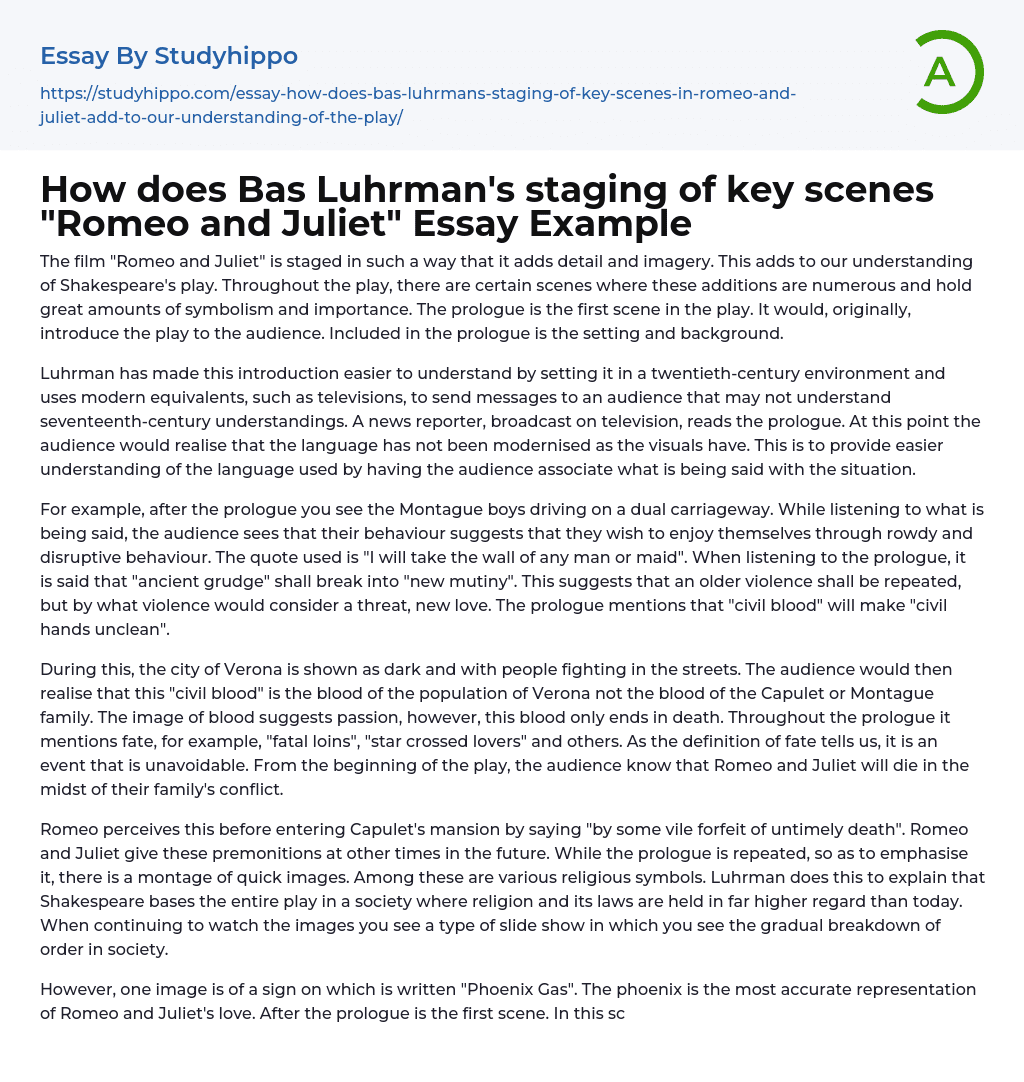

How does Bas Luhrman’s staging of key scenes “Romeo and Juliet” Essay Example
The staging of the film "Romeo and Juliet" incorporates detailed imagery, enhancing our comprehension of Shakespeare's play. Numerous scenes throughout the play feature significant symbolism and hold great importance, particularly the prologue. Originally serving to introduce the play to the audience, the prologue includes both the setting and background.
Luhrman has made the introduction more accessible by placing it in a twentieth-century setting and employing contemporary elements like televisions. These elements serve to communicate with an audience that may not be familiar with seventeenth-century context. The prologue is delivered by a news reporter through the television broadcast, indicating to the audience that the language has not been modernized like the visuals. This approach facilitates comprehension of the language by allowing the audience to connect what is being said
...with the present situation.
After the prologue, an example is presented where the Montague boys are seen driving on a dual carriageway. While their conversation is heard, their actions indicate that they are seeking enjoyment through unruly and disruptive behavior. The quote "I will take the wall of any man or maid" is utilized to illustrate this. In the prologue, it is mentioned that an "ancient grudge" will erupt into "new mutiny". This implies that a previous violence will be repeated, but by a new love that is considered a threat. The prologue also makes reference to "civil blood" causing the contamination of "civil hands."
The city of Verona is depicted as dark and filled with street brawls. This reveals that the "civil blood" mentioned refers to the blood of the Verona population, rather than that of the Capulet or Montague families. The use of blood imagery conveys intense
emotions, but ultimately results in death. The prologue consistently references fate through phrases like "fatal loins" and "star-crossed lovers". Fate is described as an inevitable event. Thus, from the onset, the audience is aware that Romeo and Juliet will meet their demise amidst their families' feud.
Romeo notices this before entering Capulet's mansion when he says "by some vile forfeit of untimely death". Romeo and Juliet give similar warnings at other moments in the future. The prologue is repeated to highlight its significance, accompanied by a series of fast-paced images. These images include various religious symbols, which Luhrman uses to show that Shakespeare sets the play in a society where religion and its regulations are highly valued compared to modern times. As the images progress, there is a gradual depiction of the deterioration of societal order.
However, there is an image of a sign that says "Phoenix Gas". The image of the phoenix resembles Romeo and Juliet's love accurately. Following the prologue is the first scene, which depicts a meeting between the Montague and Capulet boys. As the gunfight begins, the film alternates between slow and quick scenes. The slower scenes serve to extend the tension during the fight. Close-ups are used to emphasize crucial statements, like when Tybalt declares, "peace, I hate the word". The fighting intensifies to a moment where petrol starts spraying around them.
Luhrman effectively builds tension in the audience by showing the potential for conflict. The presence of a metal sign that reads "add more fuel to your fire" hints at an impending explosion. This tension manifests when a Montague character tries to flee and ends up colliding with traffic, symbolizing the
citizens of Verona being caught in the feud between the two families. The ballroom scene is particularly symbolic, as Luhrman modifies the story to illustrate Romeo's intoxication with love.
Mercutio gives Romeo L. S. D. The first half of the party is portrayed as a distorted image of love. This is evident in Mercutio singing in women's clothing and Tybalt kissing Juliet's mother. The atmosphere of the party intensifies with a crescendo of music and light. Romeo symbolically washes his face and removes his mask, signifying his transformation and new identity. It is during this time that he encounters Juliet and discovers a different kind of love. In conclusion, Bas Luhrman's direction of Shakespeare's "Romeo and Juliet" aims to provide a deeper understanding of the tragedy for a new generation. This is achieved by merging Shakespeare's words with a twentieth-century setting that the audience can relate to more easily.
- 1984 essays
- A Farewell to Arms essays
- A Good Man Is Hard to Find essays
- A Hanging essays
- A Lesson Before Dying essays
- A Long Way Gone essays
- A Rose For Emily essays
- A Separate Peace essays
- A Tale Of Two Cities essays
- A Very Old Man With Enormous Wings essays
- Adventures Of Huckleberry Finn essays
- Alice in Wonderland essays
- All Quiet on The Western Front essays
- Allegory of the Cave essays
- An occurrence at owl creek bridge essays
- Animal Farm essays
- Anthem essays
- Antigone essays
- Arthur Conan Doyle essays
- As I Lay Dying essays
- Atticus Finch essays
- Barn Burning essays
- Battle Royal essays
- Beauty and The Beast essays
- Beloved essays
- Boo Radley essays
- Brave New World essays
- Candide essays
- Castle essays
- Characters In Hamlet essays
- Characters In Romeo And Juliet essays
- Christmas carol essays
- Chronicle of a Death Foretold essays
- Cinderella essays
- Crime and Punishment essays
- Daisy Miller essays
- Death of a Salesman American Dream essays
- Desdemona essays
- Diary Of A Wimpy Kid essays
- Dracula essays
- Dubliners essays
- Emma essays
- Ender'S Game essays
- Ethan Frome essays
- Eveline essays
- Fahrenheit 451 essays
- First-Person Narrative essays
- Fish Cheeks essays
- Frankenstein essays
- Genesis essays



